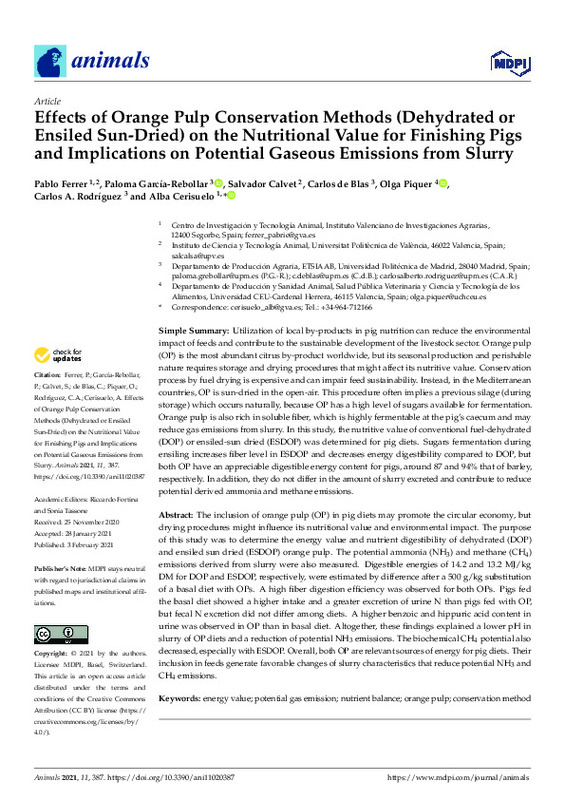JavaScript is disabled for your browser. Some features of this site may not work without it.
Buscar en RiuNet
Listar
Mi cuenta
Estadísticas
Ayuda RiuNet
Admin. UPV
Effects of Orange Pulp Conservation Methods (Dehydrated or Ensiled Sun-Dried) on the Nutritional Value for Finishing Pigs and Implications on Potential Gaseous Emissions from Slurry
Mostrar el registro sencillo del ítem
Ficheros en el ítem
| dc.contributor.author | Ferrer, Pablo
|
es_ES |
| dc.contributor.author | García-Rebollar, Paloma
|
es_ES |
| dc.contributor.author | Calvet, S.
|
es_ES |
| dc.contributor.author | de Blas, Carlos
|
es_ES |
| dc.contributor.author | Piquer, Olga
|
es_ES |
| dc.contributor.author | Rodríguez, Carlos A.
|
es_ES |
| dc.contributor.author | Cerisuelo, Alba
|
es_ES |
| dc.date.accessioned | 2022-05-13T18:05:56Z | |
| dc.date.available | 2022-05-13T18:05:56Z | |
| dc.date.issued | 2021-02 | es_ES |
| dc.identifier.uri | http://hdl.handle.net/10251/182604 | |
| dc.description.abstract | [EN] Utilization of local by-products in pig nutrition can reduce the environmental impact of feeds and contribute to the sustainable development of the livestock sector. Orange pulp (OP) is the most abundant citrus by-product worldwide, but its seasonal production and perishable nature requires storage and drying procedures that might affect its nutritive value. Conservation process by fuel drying is expensive and can impair feed sustainability. Instead, in the Mediterranean countries, OP is sun-dried in the open-air. This procedure often implies a previous silage (during storage) which occurs naturally, because OP has a high level of sugars available for fermentation. Orange pulp is also rich in soluble fiber, which is highly fermentable at the pig's caecum and may reduce gas emissions from slurry. In this study, the nutritive value of conventional fuel-dehydrated (DOP) or ensiled-sun dried (ESDOP) was determined for pig diets. Sugars fermentation during ensiling increases fiber level in ESDOP and decreases energy digestibility compared to DOP, but both OP have an appreciable digestible energy content for pigs, around 87 and 94% that of barley, respectively. In addition, they do not differ in the amount of slurry excreted and contribute to reduce potential derived ammonia and methane emissions. The inclusion of orange pulp (OP) in pig diets may promote the circular economy, but drying procedures might influence its nutritional value and environmental impact. The purpose of this study was to determine the energy value and nutrient digestibility of dehydrated (DOP) and ensiled sun dried (ESDOP) orange pulp. The potential ammonia (NH3) and methane (CH4) emissions derived from slurry were also measured. Digestible energies of 14.2 and 13.2 MJ/kg DM for DOP and ESDOP, respectively, were estimated by difference after a 500 g/kg substitution of a basal diet with OPs. A high fiber digestion efficiency was observed for both OPs. Pigs fed the basal diet showed a higher intake and a greater excretion of urine N than pigs fed with OP, but fecal N excretion did not differ among diets. A higher benzoic and hippuric acid content in urine was observed in OP than in basal diet. Altogether, these findings explained a lower pH in slurry of OP diets and a reduction of potential NH3 emissions. The biochemical CH4 potential also decreased, especially with ESDOP. Overall, both OP are relevant sources of energy for pig diets. Their inclusion in feeds generate favorable changes of slurry characteristics that reduce potential NH3 and CH4 emissions. | es_ES |
| dc.description.sponsorship | This work was supported by the Spanish Ministry of Science, Innovation and Universities (AGL2014-56653 and RTI2018-095246). | es_ES |
| dc.language | Inglés | es_ES |
| dc.publisher | MDPI AG | es_ES |
| dc.relation.ispartof | Animals | es_ES |
| dc.rights | Reconocimiento (by) | es_ES |
| dc.subject | Energy value | es_ES |
| dc.subject | Potential gas emission | es_ES |
| dc.subject | Nutrient balance | es_ES |
| dc.subject | Orange pulp | es_ES |
| dc.subject | Conservation method | es_ES |
| dc.subject.classification | PRODUCCION ANIMAL | es_ES |
| dc.title | Effects of Orange Pulp Conservation Methods (Dehydrated or Ensiled Sun-Dried) on the Nutritional Value for Finishing Pigs and Implications on Potential Gaseous Emissions from Slurry | es_ES |
| dc.type | Artículo | es_ES |
| dc.identifier.doi | 10.3390/ani11020387 | es_ES |
| dc.relation.projectID | info:eu-repo/grantAgreement/AEI/Plan Estatal de Investigación Científica y Técnica y de Innovación 2017-2020/RTI2018-095246-B-C21/ES/UTILIZACION DE SUBPRODUCTOS FIBROSOS MEJORADOS EN PIENSOS DE PORCINO PARA INCREMENTAR LA SALUD INTESTINAL Y LA SOSTENIBILIDAD DE LA PRODUCCION PORCINA/ | es_ES |
| dc.relation.projectID | info:eu-repo/grantAgreement/MINECO//AGL2014-56653-C3-1-R/ES/VALORIZACION INTEGRAL DE SUBPRODUCTOS AGROINDUSTRIALES MEDITERRANEOS (ORUJO GRASO DE ACEITUNA Y PULPA DE CITRICOS) PARA REDUCIR EL IMPACTO AMBIENTAL DE LA PRODUCCION PORCINA/ | es_ES |
| dc.rights.accessRights | Abierto | es_ES |
| dc.contributor.affiliation | Universitat Politècnica de València. Departamento de Ciencia Animal - Departament de Ciència Animal | es_ES |
| dc.contributor.affiliation | Universitat Politècnica de València. Instituto de Ciencia y Tecnología Animal - Institut de Ciència i Tecnologia Animal | es_ES |
| dc.description.bibliographicCitation | Ferrer, P.; García-Rebollar, P.; Calvet, S.; De Blas, C.; Piquer, O.; Rodríguez, CA.; Cerisuelo, A. (2021). Effects of Orange Pulp Conservation Methods (Dehydrated or Ensiled Sun-Dried) on the Nutritional Value for Finishing Pigs and Implications on Potential Gaseous Emissions from Slurry. Animals. 11(2):1-13. https://doi.org/10.3390/ani11020387 | es_ES |
| dc.description.accrualMethod | S | es_ES |
| dc.relation.publisherversion | https://doi.org/10.3390/ani11020387 | es_ES |
| dc.description.upvformatpinicio | 1 | es_ES |
| dc.description.upvformatpfin | 13 | es_ES |
| dc.type.version | info:eu-repo/semantics/publishedVersion | es_ES |
| dc.description.volume | 11 | es_ES |
| dc.description.issue | 2 | es_ES |
| dc.identifier.eissn | 2076-2615 | es_ES |
| dc.identifier.pmid | 33546423 | es_ES |
| dc.identifier.pmcid | PMC7913570 | es_ES |
| dc.relation.pasarela | S\463732 | es_ES |
| dc.contributor.funder | Agencia Estatal de Investigación | es_ES |
| dc.contributor.funder | Ministerio de Economía y Competitividad | es_ES |








